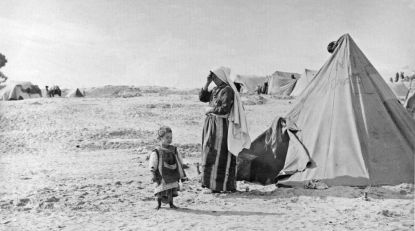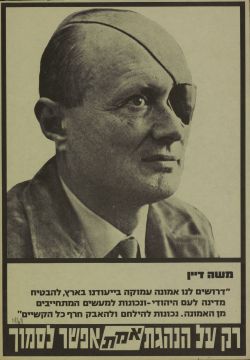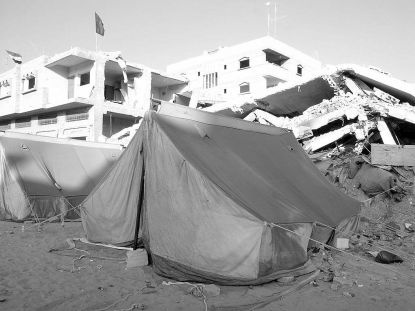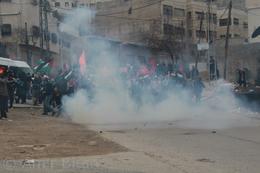The current asymmetric conflict between the state of Israel and the Palestinian resistance forces in Gaza does not merely reflect the current politics of the rulers of the two societies. It’s not just the fruit of the policies of Hamas and the current Israeli government. Certainly, they are responsible as power holders in Gaza and Israel. But a look at the history of the relationship between Israel and Gaza shows that the conflict is long-standing and has deeper roots. The present conflict is mainly a bloody continuation of one of the most difficult and unsolved wounds of the Palestinian Nakba of 1948. It is a conflict between the Zionist state and the resistance of those who became the victims of its establishment.

Palestinian refugees in Khan Younis, 1948
Since 1948, Gaza has become the largest, densest concentration of Palestinian refugees in the area. A massive number of refugees was concentrated on a tiny piece of land, doubling its population to levels beyond the carrying capacity of the Strip’s resources. Since then, residents of the Gaza Strip have been in a struggle with the Israel which decided not to allow the refugees to return and closed its gates to them. Moshe Dayan expressed this conflict well in April 1956 in his eulogy to Ro’i Rothberg, security coordinator at Kibbutz Nahal Oz, who was killed in an attack by Palestinian fighters who entered Israeli territory.
It is worthwhile to read Dayan’s eulogy closely. It contains the key to understanding the main thrust of Israeli policy toward Gaza until the 1970’s, a thrust that has reappeared from the 1990’s to today. From the beginning of the 1970’s, the years of Israeli empire, to the beginning of the 1990’s, when the politics of the fence and the closure was institutionalized, there were more than 20 years in which Israel attempted to turn the Gaza refugees into a cheap work force in the Israeli economy, while colonizing agricultural lands in the Gaza Strip. Since the end of the First Intifada, Israel retreated gradually from this experiment and resorted to the well-entrenched pattern of closure and siege; the two landmarks of this policy were the full fencing-in of the Gaza Strip (1996) and the unilateral disengagement (2005). Israel returned to the policy of closing the gates of Gaza over the heads of the refugees. This is the basic logic behind the current siege of Gaza.
Let’s read Dayan’s lament:
Yesterday morning Ro’i was murdered. The quiet of a spring morning blinded him, and he failed to see those who lurked in wait for him behind the furrow. Let us not, today, hurl accusations at the killers. Why should we complain at their fierce hatred of us? For eight years [since 1948], they have been dwelling in refugee camps in Gaza, and before their very eyes we are turning the land and the villages where they and their forefathers dwelt into our home.
It is not from the Arabs in Gaza, but among ourselves that we should seek Ro’i’s blood. How could we have failed to look our fate in the eye, to see the destiny of our generation in all its cruelty? Have we forgotten that this group of young people, living in Nahal Oz, bear on their shoulders the heavy gates of Gaza, gates beyond which are crowded hundreds of thousands of eyes and hands, praying for our weakness, so as to tear us to pieces – have we forgotten this? For we know that, in order for their hope of annihilating us to die away, it is incumbent on us – morning and night – to be armed and ready.
We are the generation of settlement, and without the steel helmet and the cannon’s mouth we cannot plant a tree nor build a house. There will be no life for our children if we do not dig shelters, and without barbed wire fences and machineguns we cannot pave roads nor drill for water. Millions of Jews, who were exterminated because they had no country, are watching us from the ashes of Israeli history and exhorting us to settle and to build up a land for our people.
But beyond the furrows of the border surges a sea of hatred and dreams of vengeance, awaiting the day when the calm dulls our alertness, when we lend an ear to the ambassadors of scheming hypocrisy, who exhort us to lay down our arms. Ro’i’s blood cries out to us from his mangled body. For we swore a thousand times that our blood would not be spilled in vain and yesterday we were beguiled once more, we listened and we believed. Let us conduct a reckoning with ourselves today. Let us not shrink from seeing the enmity, which attends and fills the lives of hundreds of thousands of Arabs, who dwell around us and await the moment when they can spill our blood. Let us not lower our gaze lest our arm be weakened. This is the decree of our generation. This is our life’s choice – to be ready and armed, strong and hardy, for if the sword slips from our fists – our lives will be cut short.
Ro’i Rothberg, the lean blond youth, who left Tel Aviv to build a home at the gates of Gaza, to be a wall for us all; Ro’i – the light in his heart dazzled his eyes, and he did not see the glint of the knife. The yearning for peace dulled his hearing, and he did not hear the sound of lurking murder. The gates of Gaza weighed too heavily on him and undid him.”

Moshe Dayan on an election poster, 1969
This lament had a decisive influence on the security-and-colonization outlook of the first generation of Zionist leaders and fighters after the establishment of the state of Israel. Two points in it are clear. The first is a total absence of sanctimoniousness and a candid recognition of the justified hatred of Palestinian refugees in Gaza toward Israel: “Why should we complain at their fierce hatred of us? For eight years [since 1948] they have been dwelling in refugee camps in Gaza, and before their very eyes we are turning the land and the villages where they and their forefathers dwelt into our home.”
As opposed to present day Zionist leaders, Dayan did not deny the Nakba, did not distort or lie in this lament, and did not try to cover it up or deny responsibility. The lands were theirs, we took them, we expelled them, and we turned their lands into our own – how will they not hate us? How will they not try to return and fight for what’s theirs?
The second point is a total absence of any willingness to redress the injustice, and a blunt declaration of a war – a long, incessant war with the Palestinians shaped by an existential “us or them” attitude. Dayan, just like Netanyahu, Lieberman, Bennett and Barak, is not looking for compromises, not for remedy or reconciliation. He does not hold the lives of both Palestinians and Israelis sacrosanct. Rather, he sees their relations as a constant and unavoidable war. Lieberman is perhaps the contemporary voice most similar to Dayan of that period, talking bluntly and devoid of any moral consideration: a view of life as an existential war.

Zeitoun district after bombing, Gaza, 2007
Dayan may have thought in terms of “a generation of settlement,” but the deeds of that generation created a reality that has reproduced itself ever since; the refugees being bombed in Gaza are the third or fourth generation of refugees, and the Israeli soldiers dying in the gates of Gaza and beyond are the third or fourth generation to the colonization of the steel helmet, the canon’s mouth and barbed wire. Our two peoples are locked in a settler-colonial Zionist logic and in the unwillingness to redress the injustices caused by the crimes of the past – and that is a trap of death and suffering.
So let's not say "we're sick of Bibi and Hamas," as some have chanted in the recent protests in Tel Aviv, but rather that we are sick of the trap of colonization, the canon's mouth, the steel helmets and the "iron domes". We are sick of the barbed wire fences and we are sick of perpetuating the crime of the Nakba. We must look at the sources of the violence that Dayan pointed to in his eulogy – not just the violence of the gun and the bomb, but also the violence of colonization, dispossession and expulsion – and deal with this violence in order to be released from the curse of war that afflicts both our peoples.
* Photographs: AP/UNRWA archive; Palestine Remembered web site.


